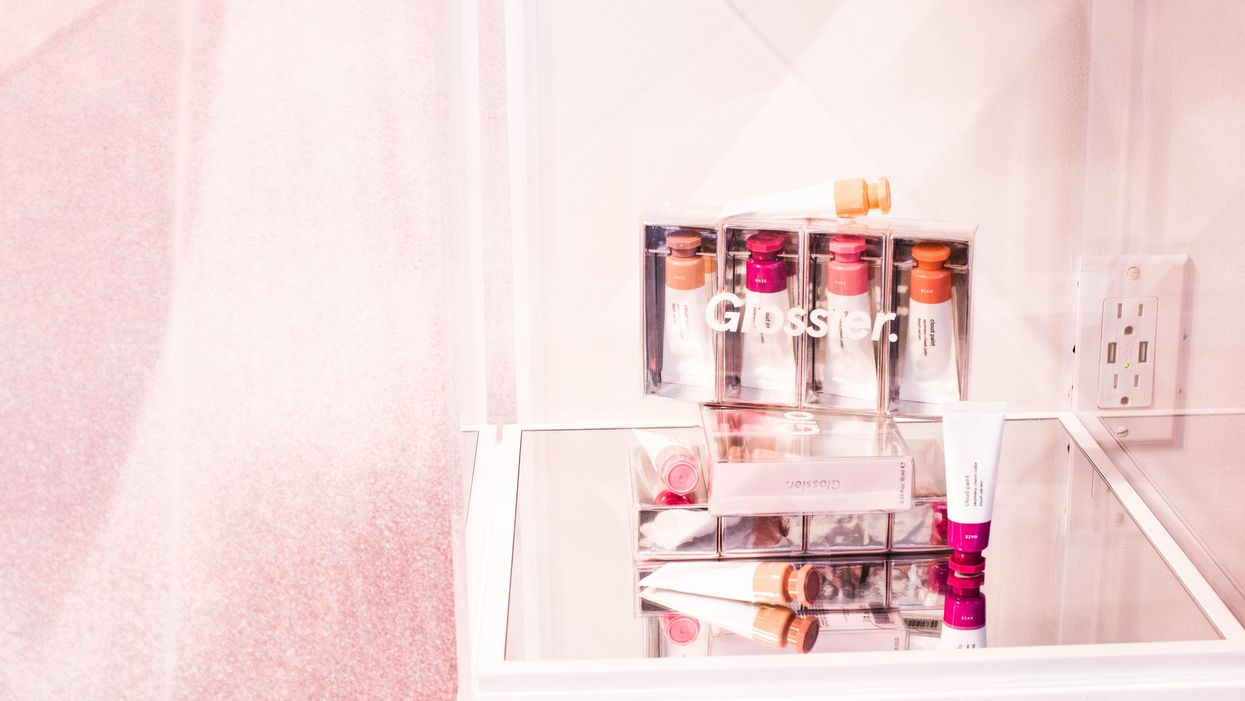Retail Channels
26 July 2022
Glossier is embracing in-person retail
With its first retail deal and more stores, the beauty brand is entering a new era where DTC is only part of the strategy.

Photo by Charisse Kenion on Unsplash
With its first retail deal and more stores, the beauty brand is entering a new era where DTC is only part of the strategy.

Glossier is about to start appearing on more store shelves.
The beauty brand that became synonymous with direct-to-consumer is making moves to expand its presence in brick-and-mortar retail. A pair of announcements issued by the brand on Tuesday make this clear:
Changing of the guard: It’s an about-face in strategy for eight-year-old Glossier, which forged a new path in cosmetics by selling through its own channels, and gained cult status among consumers in the process. On the way to a billion-dollar valuation in 2019, Founder Emily Weiss made a point of foregoing the cosmetics retailers and drug stores where the largest beauty brands compete for space. Weiss had ambitions to grow by creating a deeper tech-enabled experience, but that was abandoned amid layoffs earlier this year. That set the stage for Weiss’ departure in May. New CEO Kyle Leahy, who brings experience from Nike and Cole Haan, immediately voiced that growth through wholesale and other in-person retail would be a priority. Two months later, it's coming to fruition with an agreement in place.
Key quote: “We are incredibly excited to enter our first-ever retailer partnership with Sephora. They are an iconic, international retailer with an extremely loyal community and we know our customers want to find us there,” Leahy said in a news release. “We share the same customer-centric values and are both deeply grounded in the ever-evolving notion of beauty discovery. This marks a new chapter in our omnichannel strategy and we can’t wait for all that’s ahead in 2023.”
Part of the whole: Glossier follows fellow DTC darlings like Allbirds and Casper into the more traditional retail route. With the expansion of its own stores, Glossier is also joining Warby Parker and Everlane in embracing an omnichannel direct model that moves between both digital and in-person retail. Plenty of other newer DTC brands are embracing a strategy of starting direct with digital, then moving into physical retail and big box stores to get bigger, as well. That was on view elsewhere this week as DTC innerwear brand Parade signed its first retail partnership with Urban Outfitters. At the same time, storied brands are prioritizing direct-to-consumer to reach shoppers on a growing number of digital touchpoints. It points toward a model where DTC is less of a movement, and more of an established operational strategy.
Searches answered: While Glossier is looking to find its footing again, the brand still has plenty of the appeal that made it the balm dotcom in the first place. It was legendary for its ability to generate demand, and that carried over to Sephora even before the deal was signed. The retailer said searches looking for information on whether the brand was available at Sephora jumped 200% in the last year, and shared that it is one of the “most searched” brands not currently available at Sephora.
Year of firsts: To be sure, wholesale is just one channel for growth that Glossier is pursuing to add customers. In other firsts, the brand also signed its inaugural celebrity partnership with pop star Olivia Rodrigo, and helped to introduce YouTube's shoppable Shorts with the launch of its No.1 Pencil.
The bottom line: Still, those are moves from the DTC playbook. Wholesale is a bigger step toward traditional retail. As it enters the store, there’s no doubt that Glossier will be more widely available through Sephora. The beauty retailer has over 500 stores in the Americas, and increased its US store count by 260 in 2021 alone. Glossier is also planning to expand its own stores in the coming year with locations in Brooklyn, Philadelphia, Atlanta and its new location in New York’s Soho neighborhood. The test will be whether it can retain its singular status as a business pioneer and it factor with consumers can remain as its products join the brand's distinctive shade of pink in ubiquity.On the Move has the latest from Amazon, Lovesac and more.
Ryan Cohen is executive chairman of GameStop. (Photo by Flickr user Bill Jerome, used under a Creative Commons) license.
This week, leadership is changing at GameStop, Sorel and Beautycounter. Meanwhile, key executives are departing at Amazon, Wayfair and Lovesac.
Here’s a look at the latest shuffles:
GameStop announced the termination of Matthew Furlong as CEO on Wednesday. A brief statement did not provide a reason for the firing.
With the move, Chewy founder and activist investor Ryan Cohen was named executive chairman of the video game retailer. Cohen will be responsible for capital allocation and overseeing management.
It came as the company reported a 10% year-over-year decline in net sales for the first quarter. Meanwhile, the company’s net loss improved by 62%.
In an SEC filing, GameStop further added this “We believe the combination of these efforts to stabilize and optimize our core business and achieve sustained profitability while also focusing on capital allocation under Mr. Cohen’s leadership will further unlock long-term value creation for our stockholders.”
Cohen was revealed as GameStop's largest shareholder when he disclosed a 10% stake in the retailer in 2020. GameStop went on to become a leading name in the meme stock rise of 2021.
Mark Nenow is stepping down as president of the Sorel brand in order to focus on his health.
After rising to the role in 2015, Nenow spearheaded a transformation of Columbia Sportswear-owned Sorel from a men’s workwear brand to a fashion-focused brand that led with a women’s offering of boots, sandals and sneakers.
“Mark led the brand to sales of $347 million in net sales in 2022,” said Columbia Sportswear CEO Tim Boyle, in a statement. “His leadership has been invaluable to this company, and we wish him the very best.”
Columbia will conduct a search for Nenow’s replacement. Craig Zanon, the company’s SVP of emerging brands, will lead Sorel in the interim.
Beautycounter appointed board member Mindy Mackenzie as interim CEO, succeeding Marc Rey. According to the brand, Rey and the board “mutually decided to transition to a new phase of leadership for Beautycounter.”
McKenzie, a former executive at Carlyle, McKinsey and Jim Beam, will lead the company as it conducts a search for a permanent CEO. Additionally, former Natura & Co CEO Roberto Marques will join Beautycounter’s board as chair.
As part of the transition, Nicole Malozi is also joining the company as chief financial officer. She brings experience from Tatcha, Nike, and DFS Group Limited.
Melissa Nick, a VP of customer fulfillment for North America at Amazon, will leave the company, effective June 16, CNBC reported. Nick joined the company in 2014, and oversaw a region that included nearly 300 fulfillment centers. After doubling its supply chain footprint during the pandemic, Amazon recently reorganized its fulfillment operations to take a regional approach, as opposed to a national model that often resulted in items shipping across the country.

Jon Blotner (Courtesy photo)
Steve Oblak will retire from the role of chief commercial officer at home goods marketplace Wayfair. With the move, Jon Blotner will be promoted to chief commercial officer.
"Steve has served as a critical part of our leadership team and played a pivotal role in Wayfair's growth, helping us grow from a $250 million business when he joined to $12 billion in net revenue today,” said Wayfair CEO Niraj Shah, in a statement. “He oversaw countless milestones, from helping to launch the Wayfair brand as we brought together hundreds of sites into a single platform, to launching new categories, business lines, and geographies while overseeing our North American and European businesses, to leading our debut into physical retail.”
Blotner previously oversaw exclusive and specialty retail brands, as well as digital media at Wayfair. Before joining the company, he served as president of Gemvara.com prior to its 2016 acquisition by Berkshire Hathaway.
Furniture retailer Lovesac said Donna Dellomo will retire as EVP and CFO, and move to an advisory role, effective June 30. Dellomo was with Lovesac for six years.
Keith Siegner was appointed as the next EVP and CFO. He brings experience as CFO of esports company Vindex, as well as executive roles at Yum! Brands, UBS Securities and Credit Suisse.
Additionally, Jack Krause will retire from the role of chief strategy officer, effective June 30. His responsibilities will be divided between CEO Shawn Nelson and president Mary Fox.
“Since joining Lovesac, Jack has played an instrumental role in transforming the Company into a true omni channel retailer by helping expand our physical touchpoints and digital platform as we continue to disrupt the industry,” said Nelson, in a statement.
The National Retail Federation announced the addition of five new board members. They include: